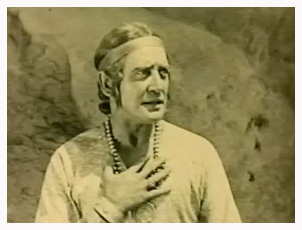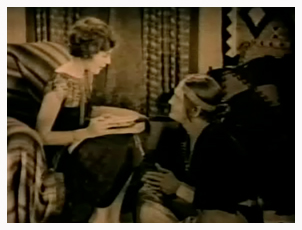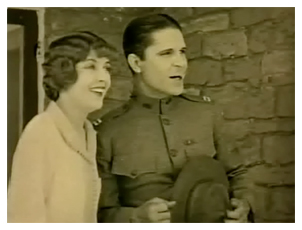

Paramount Pictures
Released February 15, 1926
Directed by George B. Seitz
Cast: Richard Dix (Nophaie), Lois Wilson (Marian Warner), Noah
Beery (Henry Booker), Malcolm McGregor (Earl Ramsdale), Nocki
(Indian boy), Shannon Day (Gekin Yashi), Charles Crockett (Amos
Halliday), Bert Woodruff (Bart Wilson), Bernard Siegel (Do Etin),
Guy Oliver (Kit Carson), Joe Ryan (Jay Lord), Charles Stevens
(Shoie), Bruce Gordon (Rhur), Richard Howard (Glendon), John Webb
Dillon (Naylor).
"The Vanishing American" is truly one of the classics of the silent era and one that any silent movie fan should see. Unfortunately, at the time of this writing (January 2016), both the VHS tape released by Kino in 1999 and the DVD released by Image Entertainment in 2000 are out of print. Both editions are from the same source and have a John Muri organ score that was recorded at a live screening - and actually both can be found online. A used copy of the VHS can be found reasonably priced at around $20, however, the DVD is usually closer to $100 for a used copy and over $125 for a new copy.
Admittedly, this reviewer did not place a high priority
on viewing this film over the years since it was assumed it was
more docu-drama than good storytelling. I was wrong. Yes, it's
true there's a documentary flavor to the first couple of reels
since the modern story with our stars doesn't get underway until
28 minutes into the film, but for most, those introductory minutes
will be interesting from a historical/informative perspective,
but still entertaining. A spectacular battle sequence is staged
for the cliff dwellers that Harrison's Reports called "impressive"
(1), with the New York Times saying, "The battle scene
is a work of art, as one perceives the primitive spears being
thrown helter-skelter among the lazy mass of  cliff-dwellers."
(2)
cliff-dwellers."
(2)
This introductory section traces the evolution of the Indians beginning with brief scenes of cave men, a race known as the "basket-makers," the cliff dwellers, and then the Native Americans as we have seen them portrayed in Westerns. This takes us to the present day (the 1920's) when we are introduced to Amos Halliday who is a weak Indian agent who leaves direct dealings with the Indians to his unscrupulous assistant Henry Booker. Booker sees the Indians only as a means to pad his pockets by having his cronies confiscate their horses sell them - all without Halliday's knowledge.
The most respected of the Indians is Nophaie who does what he can to represent his people to the agent, but, as noted, Halliday is weak, placing all of his trust in Booker. Nophaie is befriended by Marian Warner, the local schoolteacher, who respects the Indians and loves the Indian children in her care.
The corrupt and avaricious dealings of Booker and his men is illustrated with exceptional emotion when we see Nasja, the little Indian boy, out by himself with his pinto. Two white men come along, take the horse and meanly push Nasja aside. The boy watches helplessly as the men ride away with his horse. Nophaie sees this, gathers up the boy and goes to Halliday. Of course, Halliday sends him to Booker. He finds Booker talking to Marian on the school playground. When Booker is confronted with the situation, he claims the horse is sick and must be taken to protect the other horses - the boy will be given $25 for his horse by the government. After Booker leaves, Marian urges Nophaie not to be "hasty" in his actions. The friendship between the two becomes evident at this point when Nophaie tells Marian he saw her pull away from Booker when he touched her. "If you need me, you have only to call, Little White rose! Just the little cry, and it will come to me . . ."
That promise is fulfilled later when Booker tries to force himself on Marian in the schoolhouse at the end of the school day after all the children have left. Nophaie is riding by, hears Marian, and rushes in for a fight with Booker. However, four of Booker's men come in, and it appears they are about to kill him when he suddenly breaks away and rides off on his horse. Marian has run to get Halliday, but when she returns, Booker, of course, lies about the incident. He claims the altercation came about when he walked in and found Marian and Nophaie "together." When he tried to intervene, Nophaie retaliated. The men back up Booker's story, so Halliday is unable to do anything. Halliday then orders Booker to find Nophaie and bring him back.
Such is the drama and good stuff, too, with the likes of first-rate actors like Dix, Wilson and Beery. The relationship between Marian and Nophaie piques our interest throughout the film with director Seitz wisely keeping us guessing as to the depth of this rapport. We know Marian thinks well of Nophaie, and he obviously has great admiration for her, but is it forbidden for a white woman to love an Indian in our story? The film doesn't really let us know what Marian's feelings are exactly at this point, and that is good. To further keep us intrigued, another romantic interest enters the picture in the form of Captain Earl Ramsdell of the U.S. Army.
Ramsdell has come to collect horses that Halliday was ordered
by the government to get from the Indians for military use.  Booker explains, "You have no idea, Captain
Ramsdell, how surly and obstinate our Indians are! They positively
refused to bring their horses in, that's all!" There are,
of course, more horses, but the Indians are reluctant to bring
them in because of past dealings with Booker. Marian enters the
picture and notes that the horses can be procured if Nophaie approves
- although he is presently in hiding. Nasja takes Marian to Nophaie
where she pleads with him to provide the horses for the military.
Booker explains, "You have no idea, Captain
Ramsdell, how surly and obstinate our Indians are! They positively
refused to bring their horses in, that's all!" There are,
of course, more horses, but the Indians are reluctant to bring
them in because of past dealings with Booker. Marian enters the
picture and notes that the horses can be procured if Nophaie approves
- although he is presently in hiding. Nasja takes Marian to Nophaie
where she pleads with him to provide the horses for the military.
Weeks go by as they wait for Nophaie to act, and, during that time, Marian and Ramsdell are together quite often. It appears a romantic relationship is beginning. Finally, Nophaie arrives with a very large supply of horses. Ramsdell and his soldiers leave to fight the war, and Nophaie and the other Indians volunteer to go, too. Also, in the next scenes - with history to back this up - the Indians serve valiantly in battle.
The World War I battle scenes are even more impressive than the one staged with the cliff dwellers. "These fighting scenes are wrought with great artistry and matchless photography," said the New York Times. (3)
After a high intensity six minutes of battle, during which Nophaie saves Ramsdell's life, the Indians return home only to find Halliday gone, Booker in charge, and virtually everything of the Indians confiscated, including their fields.
The climax of the film doe not disappoint with a spectacular attack by the Indians, Nophaie trying to stop the uprising, Marian's life in danger, and Booker and one of his men readied in an upper room with a machine gun for the Indians' arrival.
Zane Grey's original serialized novel of "The Vanishing American" was published in Ladies' Home Journal in 1922-1923. Both government agents and missionaries were portrayed as taking advantage of the Indians. According to Zane Grey biographer Thomas Pauly, afterwards "the magazine was deluged with angry letters from religious groups, and the Bureau of Indian Affairs vehemently denounced his depiction of their efforts." (4) The result in the filmed version is that the Indian agent, Halliday, is portrayed as kind to the Indians, and the mistreatment is placed upon one corrupt character - Booker.
It certainly was one of Paramount's most ambitious and prestigious productions of the silent era with "thousands of Navajo Indians," "hundreds of extras," (5) and location shooting that lent great authenticity to the film. Filming took place in Arizona between June and September under harsh conditions for the actors. Some interesting "Letters from Location" were provided by both Lois Wilson and Richard Dix that give some insight into their stay. In one letter, Wilson said, "We are near Kayenta, one hundred and sixty miles from the nearest railroad, on the Navajo reservation, surrounded by desert scenery and thirty-five thousand Indians . . . We have had rainstorms, sandstorms, heat that sent the mercury up to one hundred and thirty degrees, locations that could be reached only by long horseback rides and sometimes only by mule-pack. In some places, every drop of water had to be hauled over trackless rocks for miles, and conserved carefully, a bit at a time doled out to us; and several times we have skipped meals, not through any desire to diet but because there was nothing to eat." (6)
Dix wrote of one day of filming: "July 16th: Rain in the desert! They manufactured a storm for us today, and it was so hot that the feel of the drops trickling down our necks was marvelous . . . From the dripping coolness of the shower, I went to an interior scene - yes, we have interiors in the middle of the desert! - and the combination of 120 in the shade, sand, and Klieg lights nearly put my eyes out of business. When we left the set at 6:30, there was a box of dozens of bottles of ice-cold ginger ale. 'What a property-man!' we cried and patted him on the back. But, come to find out about it, it was a happy thought of Lois' - she had thought of us suffering in the heat and sent it out." (7)
Viewing the film today, it has everything going for it.
The story is socially significant, especially in light of the
time in which it was made. The photography is stunning, the acting
is  superb, the story is emotionally
engrossing, and the action scenes are very well done. Also, other
than the leads, the film is mostly composed of Indians in the
roles - almost all non-professionals. For example, one of the
most endearing parts in the film is of the little Indian boy,
Nasja. We are told he is a real Indian boy who really doesn't
have a name and doesn't speak English. A title tells us, "The
character of Nasja is played by Man Hammer's Oldest Boy, who has
no name of his own. Nor will he have until he does something to
distinguish himself among the people of his tribe." Dix noted
that Bernard Siegel (Do Etin) and Shannon Day (Gekin Yashi) were,
other than himself, the only "white Indians" among "10,000
red ones." (8)
superb, the story is emotionally
engrossing, and the action scenes are very well done. Also, other
than the leads, the film is mostly composed of Indians in the
roles - almost all non-professionals. For example, one of the
most endearing parts in the film is of the little Indian boy,
Nasja. We are told he is a real Indian boy who really doesn't
have a name and doesn't speak English. A title tells us, "The
character of Nasja is played by Man Hammer's Oldest Boy, who has
no name of his own. Nor will he have until he does something to
distinguish himself among the people of his tribe." Dix noted
that Bernard Siegel (Do Etin) and Shannon Day (Gekin Yashi) were,
other than himself, the only "white Indians" among "10,000
red ones." (8)
In spite of all the positives, though, critics seemed to find fault with many aspects of the film while still praising it as a worthwhile production. Variety said although it "has been widely heralded as the 'picture of pictures, (it) failed to live up to the advance work done for it. While it proves to be a picture that will undoubtedly get money . . . it does not give . . . indications of possessing the possibilities that will make it stand out as a box office winner on a special run." (9) Photoplay said, "It might have been one of the outstanding pictures of the screen. Impressive, gloriously beautiful in its natural settings, a fine and worthy theme, with an original score worth the price of admission itself. Yet, robbed of greatness by mawkishly sentimental and overwritten titles and mediocre direction of its intimate scenes." However, the reviewer closed with, "You won't waste your money or your evening with this picture . . ." (10) The New York Times echoed what many other said in that, in spite of some "shortcomings," it is "a photodrama which is a fine accomplishment." (11)
Noah Beery seemed to be singled out among the cast for the most criticism, however. Photoplay said his performance was a "badly overdrawn characterization of a movie villain." (12) The New York Times said, "Noah Beery is 'a trifle too vehement, too vicious and venomous.'" (13) And Picture Play chimed in, "Noah Beery, as the bad man, seemed a little too leering for a modern story." (14) For this reviewer, Noah Beery is one of the top two or three bad men in silent cinema, and, personally, his performance was right on target for drawing out the intended emotions from the viewer - so much so that when Halliday finally fires Booker, cheers and applause can be heard from the audience on the home video's live soundtrack.
Lois Wilson, on the other hand, isn't treated necessarily badly, but there are no over-the-top plaudits, either. Variety said she was "sincere and an altogether charming heroine." (15) The New York Times did criticize in a somewhat difficult to understand statement. " . . . Miss Wilson reminds one of the fact too frequently, what with blinking her eyes to a sort of Morse code and wearing gowns that would be apt to attract any scoundrel." (16) Picture Play thought she "seemed almost unbearably sweet." (17) Even though the criticism is mild, this reviewer begs to differ feeling Lois Wilson gave a superb, underplayed, yet sympathetic and moving, performance. Also, of the half a dozen or so silent features in which this reviewer has seen her appear, for some reason, she has never looked lovelier than in "The Vanishing American."
As for Malcolm MacGregor, there's not much to say. He's given a rather straightforward part as Captain Ramsdell and not a whole lot to do other than demand some action from Halliday on providing the horses he's come for. His good looks do make him a good choice for a possible love interest for Lois Wilson, and that's basically what he's there for.
Richard Dix's performance is mostly (according to the reviews) beyond reproach. He is very believable as a Native American, and his performance is appropriately restrained and dignified. The Picture Play reviewer describes it well. "At no time is he the usual, pleasant, smiling Mr. Dix who steps in and out of sport roadsters so easily. He has become, as Nophaie, one of a waning people making a last flurry of protest against the civilization surrounding them. He plays with dignity and reserve, and seems on the whole, more like a real Indian than many actors I have seen who have that sort of role . . . Some of Mr. Dix's close-ups were a little trying, but not once did he fall into stagy, conventional attitudes. He didn't fold his arms once, to my knowledge, nor did he wrap a blanket around himself and look toward the setting sun. (18) Variety said, "Dix gives a corking performance as the Indian leader," (19) and Harrison's Reports noted that Dix "lives the part." (20).
"The Vanishing American" is one of the great western epics of the silent film era. Westerns were plentiful in the teens and twenties. Most were low budget "B" films, although, most notably, the films of William S. Hart or Tom Mix would hardly fall into the "B" category. Big budget, epic adventures were only occasional treats as exhibited by such memorable films as "The Covered Wagon" (1923), "The Iron Horse" (1924) or "The Winning of Barbara Worth" (1926). "The Vanishing American" certainly deserves a place with the best of them and as one of the great silents. To be sure, it's a must-see for any true silent movie fan - so, unless you were one of the lucky fans who purchased the VHS tape or DVD several years ago when they were available - or had the pleasure of seeing this at a live performance - it's highly recommended you locate one of the reasonably priced used copies out there and treat yourself to a first-rate evening's entertainment.
References:
1. "Vanishing American, The" review. Harrison's Reports.
October 24, 1925.
2. "Vanishing American, The" review. New York Times.
October 16, 1925.
3. Ibid.
4. Steffen, James. "The Vanishing American." TCM.com.
5. "Indian Head Pennies in Demand: Worth 150 Per Cent at
Victoria." The (Harrisburg, PA) Evening News. February
20, 1926. Pg. 12.
6. Wilson, Lois. "A Letter from Location." Picture
Play. January 1926.
7. Dix, Richard. "This is the Life!" Motion Picture.
December 1925.
8. Ibid.
9. "Vanishing American, The" review. Variety.
October 21, 1925.
10. "Vanishing American, The" review. Photoplay.
December 1925.
11. New York Times.
12. Photoplay.
13. New York Times.
14. "Vanishing American, The" review. Picture Play.
January 1926.
15. Variety.
16. New York Times.
17. Picture Play review.
18. Ibid.
19. Variety.
20. Harrison's Reports.
Copyright 2016 by Tim Lussier. All rights reserved